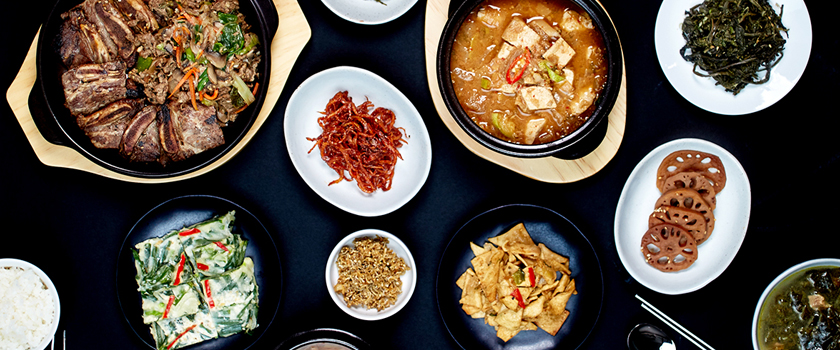Korean cuisine originated from ancient prehistoric traditions in the Korean peninsula evolving through a complex interaction of environmental, political, and cultural trends. Korean cuisine is mainly based upon rice, noodles, tofu (or 두부 in Korean), vegetables, and meats.
Traditional Korean meals are noted for the number of side dishes (반찬) that accompany steam-cooked short-grain rice. Kimchi(김치) is served often, sometimes at every meal. Commonly used ingredients include sesame oil, doenjang (된장,fermented bean paste), soy sauce, salt, garlic, ginger, pepper flakes and gochujang (고추장,fermented red chili paste).
Different province has different kinds of Ingredients and dishes in Korea. Many regional dishes have become national, and dishes that were once regional have proliferated in different variations across the country. The Korean royal court cuisine once brought all of the unique regional specialties together for the royal family.
Meals are regulated by Korean cultural etiquette. Grains usually is one of the most important staples to the Korean diet. Early myths of the foundations of various kingdoms in Korea center on grains. One foundation myth relates to Jumong, who received barley seeds from two doves sent by his mother after establishing the kingdom of Goguryeo.
Yet another myth speaks of the three founding deities of Jeju Island who were to be wed to the three princesses of Tamna; the deities brought seeds of five grains which were the first seeds planted, which in turn became the first instance of farming.
During the pre-modern era, grains such as barley and millet were the main staples and were supplemented by wheat, sorghum, and buckwheat. Rice is not an indigenous crop to Korea, and it is likely millet was the preferred grain before rice was cultivated. Rice became the grain of choice during the Three Kingdoms period, particularly in the kingdoms of Silla and Baekje in the southern regions of the peninsula.
Rice was such an important commodity in Silla that it was used to pay taxes. The Sino-Korean word for “tax” is a compound character that uses the character for the rice plant. The preference for rice escalated into the Joseon period, when new methods of cultivation and new varieties emerged that would help increase production.
As rice was prohibitively expensive when it first came to Korea, it is likely the grain was mixed with other grains to “stretch” the rice; this is still done in dishes such as boribap (rice with barley) and kongbap (rice with beans). White rice, which is rice with the bran removed, has been the preferred form of rice since its introduction into the cuisine.
The most traditional method of cooking the rice has been to cook it in an iron pot called a sot (솥) or musoe sot (무쇠솥). This method of rice cookery dates back at least to the Goryeo period, and sot have even been found in tombs from the Silla period.
The sot is still used today, much in the same manner as it was in the past centuries. Rice is used to make a number of items, outside of the traditional bowl of plain white rice.
It is commonly ground into a flour and used to make rice cakes called tteok, of which there are over two hundred varieties. It is also cooked down into a congee (juk), or gruel (mieum) and mixed with other grains, meat, or seafood. Koreans also produce a number of rice wines, both in filtered and unfiltered versions.
Read Also: Translation of Chinese and Western Dishes



